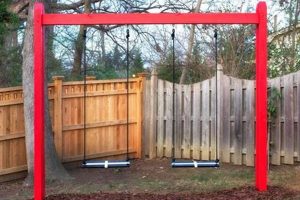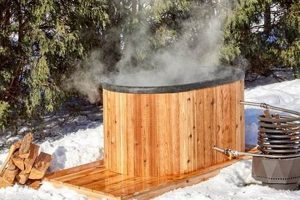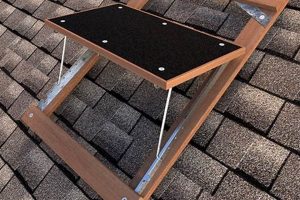The construction of straightforward, self-assembled wooden platforms presents a method for creating accessible elevation changes. These structures offer a practical solution for navigating slight inclines or creating small rises in both interior and exterior environments. For example, a homeowner might employ this technique to build a small set of risers leading to a deck or to address a single step transition within a living space.
Implementing such a solution provides several advantages. It can enhance accessibility, improve safety by mitigating tripping hazards, and offer a cost-effective alternative to professional construction. Historically, the creation of these platforms has been a fundamental skill in carpentry, adapting to diverse needs across residential and commercial landscapes. The approach allows for customization and personalization based on individual requirements and aesthetic preferences.
The subsequent sections will detail the essential materials, tools, and step-by-step instructions necessary for successful implementation. These sections will also address safety considerations and provide guidance on adapting designs to suit various spatial constraints and desired finishes. Careful planning and precise execution are crucial for ensuring structural integrity and long-term durability of the finished product.
Essential Considerations for Constructing Wooden Platforms
Successful creation of simple wooden risers requires attention to detail and adherence to best practices. The following guidelines will enhance structural integrity, safety, and aesthetic appeal.
Tip 1: Material Selection. Choose lumber appropriate for the intended environment. Pressure-treated wood is essential for outdoor applications to resist decay and insect infestation. Indoor projects may utilize hardwoods for a refined appearance.
Tip 2: Precise Measurement and Planning. Accurate dimensions are paramount. Measure the rise and run of the intended steps meticulously. A detailed sketch or plan will prevent errors and ensure a consistent, professional result.
Tip 3: Secure Fastening Techniques. Employ screws rather than nails for superior holding power. Pre-drilling pilot holes prevents wood splitting and ensures screws seat flush with the surface. Consider using construction adhesive for added stability.
Tip 4: Consistent Step Height. Maintain uniform rise between each step. Inconsistent step heights pose a significant tripping hazard. Use a level and measuring tape to verify consistency throughout the project.
Tip 5: Proper Support and Framing. Adequately support the structure with sturdy framing. This is particularly critical for wider or taller configurations. Consult local building codes for span requirements and load-bearing considerations.
Tip 6: Surface Treatment and Finishing. Apply a protective coating to enhance durability and weather resistance. For outdoor steps, use a sealant specifically designed for wood exposed to the elements. Indoor steps may benefit from paint or stain to complement the surrounding dcor.
Tip 7: Consider Code Compliance. Verify compliance with local building codes regarding step height, depth, and handrail requirements. This is essential for ensuring safety and avoiding potential legal issues.
Adherence to these recommendations will result in a durable, safe, and aesthetically pleasing structure. Meticulous planning and precise execution are crucial for achieving a professional-grade outcome.
The following section will explore advanced techniques and design modifications for creating more complex configurations. This includes strategies for incorporating handrails, lighting, and other features to enhance functionality and visual appeal.
1. Precise Measurements
Accurate measurements are paramount to the successful creation of safe and functional wooden platforms. The dimensional integrity of each component directly impacts the overall stability and usability of the structure. Deviation from prescribed dimensions can lead to structural weaknesses, safety hazards, and aesthetic inconsistencies. The following facets illustrate the critical role of dimensional accuracy in achieving a desirable outcome.
- Riser Height Consistency
Maintaining uniform height across all risers is crucial for preventing trips and falls. Even slight variations in riser height can disrupt a user’s gait, increasing the risk of accidents. For example, if one riser is even a quarter of an inch higher than the others, it can become a significant hazard, especially for individuals with mobility limitations. Adherence to consistent measurements ensures a predictable and safe ascent or descent.
- Tread Depth Accuracy
The depth of each tread must be sufficient to provide adequate foot support. Insufficient tread depth compromises balance and increases the likelihood of slips. Consider an outdoor installation where a short tread, especially when wet, could easily cause a user to misstep. Precise measurements ensure each tread offers a secure and stable surface for foot placement.
- Stringer Angle Calculation
The angle at which the stringers are cut directly affects the overall incline of the steps. An inaccurate angle can result in an uncomfortable or even dangerous slope. For instance, if the stringer angle is too steep, the steps become difficult to navigate, particularly for elderly users or those carrying objects. Accurate angular calculations are essential for creating a comfortable and safe incline.
- Overall Dimensional Conformance
The cumulative effect of individual dimensional inaccuracies can lead to a structure that deviates significantly from its intended design. This can result in structural instability and compromised functionality. For example, if the overall height or width of the platform is significantly off, it may not fit properly in its intended location or may not provide the required access. Accurate adherence to the planned dimensions ensures the finished product meets its intended purpose and integrates seamlessly into its surroundings.
In summary, meticulous attention to dimensional accuracy is not merely a matter of aesthetic preference, but a fundamental requirement for ensuring the safety, stability, and functionality of wooden platforms. Neglecting precise measurements can result in a structure that is not only visually unappealing but also poses a significant risk to users. The investment of time and effort in accurate measurements is therefore a critical component of any successful project.
2. Proper Wood Selection
The selection of appropriate wood is paramount to the longevity, safety, and aesthetic appeal of any self-assembled wooden platform. This aspect transcends mere cost considerations, influencing the structural integrity and resistance to environmental factors. The decision regarding wood type dictates the overall success of the project.
- Species-Specific Strength and Durability
Different wood species possess varying inherent strengths and resistances to decay, insect infestation, and wear. For outdoor applications, pressure-treated lumber, such as Southern Yellow Pine, is often employed due to its enhanced resistance to rot. Indoor projects might utilize hardwoods like oak or maple for their aesthetic qualities and increased durability under less demanding conditions. The choice directly impacts the platform’s lifespan and maintenance requirements.
- Moisture Content and Dimensional Stability
Wood’s moisture content affects its dimensional stability, influencing the likelihood of warping, cracking, or shrinking after construction. Kiln-dried lumber minimizes these risks, ensuring a more stable and predictable finished product. This is particularly critical for platforms exposed to fluctuating humidity levels, as dimensional changes can compromise the integrity of joints and fasteners.
- Workability and Ease of Construction
Certain wood species are easier to work with, facilitating simpler construction processes. Softwoods like pine are generally easier to cut, drill, and fasten than hardwoods. However, they may also be more prone to damage during construction. The choice depends on the constructor’s skill level and the complexity of the design. Ease of workability can significantly affect the time and effort required to complete the project.
- Aesthetic Considerations and Finish Compatibility
The appearance of the wood, including its grain pattern and natural color, contributes to the platform’s overall aesthetic. Different wood species accept stains and finishes differently, influencing the final visual outcome. For example, redwood offers a natural reddish hue and accepts stains readily, while cedar is known for its aromatic properties and resistance to insects. The chosen wood should complement the surrounding environment and align with the desired design aesthetic.
Therefore, the selection of appropriate wood for self-assembled wooden platforms extends beyond simple material procurement. It constitutes a crucial design decision that directly impacts the structure’s durability, safety, ease of construction, and aesthetic appeal. Careful consideration of these factors will contribute significantly to the successful and long-lasting implementation of easy diy wooden steps.
3. Secure Fastening
Effective construction of wooden platforms fundamentally relies on secure fastening techniques. This element directly influences the structural integrity, stability, and longevity of the finished product. Insufficient or improper fastening can lead to premature failure, safety hazards, and ultimately negate the intended benefits of a self-assembled structure. For example, a simple set of exterior wooden risers constructed with improperly secured treads may deteriorate rapidly, resulting in loose boards and an increased risk of falls, especially under wet or icy conditions. The relationship between fastening security and the utility of wooden platforms is, therefore, a direct cause-and-effect dynamic.
The selection of appropriate fasteners is paramount. Screws generally offer superior holding power compared to nails, particularly in applications subject to fluctuating environmental conditions. Pre-drilling pilot holes prevents wood splitting and ensures fasteners seat correctly, maximizing their grip. Furthermore, the strategic application of construction adhesive in conjunction with mechanical fasteners provides an additional layer of bonding, enhancing resistance to shear and tensile forces. Consider, for instance, the construction of a platform designed to support heavy loads; without adequate and secure fastening, the structure would likely deform or collapse under stress, rendering it unusable and potentially dangerous. The spacing and pattern of fasteners must also be carefully considered based on the load-bearing requirements of the platform.
In summary, secure fastening is not merely a procedural step in the construction of wooden platforms; it represents a crucial determinant of the structure’s overall success. Proper techniques, appropriate fastener selection, and meticulous execution are essential for ensuring a durable, safe, and reliable outcome. The consequences of neglecting secure fastening range from aesthetic deficiencies to catastrophic structural failure, underscoring its critical importance in the context of self-assembled wooden platforms.
4. Level Surface
The creation of stable and safe wooden platforms is inextricably linked to the concept of a level surface. In the context of “easy diy wooden steps”, a level surface serves as a fundamental prerequisite for both the base upon which the structure rests and the individual treads that comprise the steps themselves. A non-level base introduces instability, potentially leading to structural failure or gradual deterioration over time. Uneven treads create a significant tripping hazard, directly compromising user safety.
Consider a practical example: A homeowner constructs a small set of wooden steps leading to a garden path. If the underlying ground is uneven or sloped, the base of the steps will not have uniform contact with the supporting surface. This lack of contact will result in stress points within the structure, leading to warping, sagging, and eventual collapse. Furthermore, if the treads are not meticulously leveled during construction, even slight variations in height can cause users to stumble, particularly in low-light conditions or when carrying objects. The significance of a level surface, therefore, extends beyond mere aesthetic considerations, directly impacting the functionality and safety of the steps.
Achieving a level surface requires careful site preparation and the use of appropriate leveling tools. This may involve excavating and compacting the ground beneath the steps, utilizing shims to compensate for minor irregularities, and consistently employing a level to verify horizontal alignment. While the task may seem straightforward, neglecting this critical step can undermine the entire project, rendering the resulting steps unstable, unsafe, and ultimately, an ineffective solution. The connection between a level surface and functional wooden platforms is not merely correlational but causational, representing a foundational principle in the design and construction of “easy diy wooden steps”.
5. Durable Finish
The application of a durable finish to self-assembled wooden platforms is a critical factor influencing longevity, maintenance requirements, and overall aesthetic appeal. Its role extends beyond mere cosmetic enhancement, serving as a protective barrier against environmental stressors and daily wear. The absence of a suitable finish diminishes the lifespan and compromises the structural integrity of “easy diy wooden steps”.
- Protection from Weathering
Exterior wooden steps are continuously exposed to the elements, including rain, sunlight, and temperature fluctuations. A durable finish, such as a weather-resistant sealant or paint, shields the wood from moisture absorption, preventing rot, warping, and cracking. Without such protection, the wood will degrade over time, requiring costly repairs or replacement. Consider steps exposed to direct sunlight: an appropriate UV-resistant finish mitigates fading and surface damage.
- Resistance to Abrasion and Wear
Foot traffic subjects the surface of wooden steps to constant abrasion. A durable finish provides a protective layer that resists scratching, scuffing, and general wear, preserving the aesthetic appeal and structural integrity of the treads. For instance, applying a polyurethane coating to interior wooden steps increases their resistance to wear from shoes, pets, and furniture, extending their useful life.
- Prevention of Insect Infestation
Certain wood-boring insects can cause significant damage to wooden structures. Some durable finishes contain insecticides that deter these pests, preventing infestations and structural weakening. The application of a borate-based wood preservative, followed by a protective topcoat, can significantly reduce the risk of insect damage, especially in areas prone to termite activity.
- Enhancement of Aesthetic Appeal
A durable finish not only protects the wood but also enhances its natural beauty. Stains can accentuate the grain pattern and color, while clear coatings provide a glossy or matte sheen. A properly applied finish transforms raw lumber into an aesthetically pleasing element of the surrounding environment, complementing architectural styles and enhancing visual appeal. Consider a simple wooden staircase: a well-chosen stain and protective varnish can elevate its appearance from functional to elegant.
The selection and application of a durable finish are integral to the success of “easy diy wooden steps.” It is an investment in the longevity, safety, and aesthetic value of the structure. A well-executed finish minimizes maintenance requirements, protects against environmental damage, and enhances the overall appeal of the wooden platform, contributing to a durable and attractive addition to any environment.
6. Code Compliance
Adherence to local building codes is a non-negotiable aspect of constructing wooden platforms, regardless of project scale or perceived simplicity. This aspect directly impacts safety, accessibility, and legal compliance. Deviation from stipulated codes can lead to structural instability, increased risk of injury, and potential legal repercussions. The construction of “easy diy wooden steps” is therefore inextricably linked to the necessity for code adherence, as even seemingly minor infractions can have significant consequences.
Building codes establish minimum standards for riser height, tread depth, handrail requirements, and load-bearing capacity. For instance, a local building code might specify a maximum riser height of 7.75 inches and a minimum tread depth of 10 inches for residential steps. Failure to comply with these dimensions can create a tripping hazard, particularly for individuals with mobility limitations. Similarly, codes often mandate the presence and specifications of handrails to prevent falls. The absence of properly installed handrails, even on a short set of steps, increases the risk of accidents. Furthermore, the structure must be able to withstand anticipated loads, requiring proper material selection and construction techniques. Ignorance or disregard of these regulations can result in structural failure, potentially causing serious injury or property damage. Building permits and inspections are often required to ensure compliance, offering an independent verification of safety and structural integrity. Failure to obtain necessary permits can result in fines, legal action, and the requirement to dismantle non-compliant structures.
In conclusion, code compliance is not merely a bureaucratic hurdle but a fundamental component of “easy diy wooden steps” construction. It serves to protect individuals from potential hazards, ensures structural stability, and prevents legal complications. Diligent research and adherence to local building codes are essential for ensuring the safety, longevity, and legality of any wooden platform project.
Frequently Asked Questions
The following section addresses common inquiries regarding the construction of straightforward wooden platforms, providing clarity on essential aspects and dispelling potential misconceptions.
Question 1: What are the fundamental safety precautions to observe during wooden platform construction?
Eye protection, respiratory masks, and appropriate gloves are imperative. Power tools necessitate adherence to manufacturer safety guidelines. A stable work surface and proper lifting techniques are crucial for injury prevention. Awareness of overhead power lines is essential during exterior projects. Ensuring a clear and well-lit workspace minimizes risks.
Question 2: How does one determine the appropriate lumber grade for wooden platforms?
Lumber grade selection depends on the platform’s intended use and exposure to the elements. Pressure-treated lumber is recommended for outdoor applications to resist rot and insect infestation. Higher grades, such as select or clear, offer superior aesthetic qualities for indoor projects. Load-bearing requirements influence the necessary strength and density of the chosen lumber.
Question 3: What is the recommended method for ensuring consistent riser height when constructing a set of wooden steps?
A story pole or pre-cut template facilitates accurate and consistent riser height measurement. Precise marking and cutting of stringers are essential. A level and measuring tape are required to verify consistency throughout the project. Inconsistent riser heights constitute a significant tripping hazard and must be rectified.
Question 4: How does one properly prepare a site for the installation of wooden platforms?
Site preparation involves clearing debris, leveling the ground, and ensuring adequate drainage. Compacted gravel or concrete pads provide a stable foundation. Proper site preparation minimizes the risk of settling or shifting, which can compromise the structural integrity of the platform. Addressing soil conditions is a prerequisite for long-term stability.
Question 5: What are the essential tools required for constructing simple wooden platforms?
A circular saw, drill/driver, level, measuring tape, square, and safety glasses are fundamental. Additional tools, such as a miter saw or router, may be required for more complex designs. Proper maintenance and safe operation of power tools are crucial. Investing in quality tools enhances efficiency and precision.
Question 6: How does one maintain wooden platforms to ensure longevity and prevent deterioration?
Regular cleaning to remove debris and prevent moisture buildup is essential. Periodic inspection for signs of rot, insect damage, or loose fasteners is necessary. Application of a protective sealant or stain every one to two years prolongs the life of the wood. Addressing minor repairs promptly prevents further deterioration.
These responses provide a foundational understanding of crucial elements involved in wooden platform construction. Further research and consultation with experienced professionals are encouraged for more complex projects.
The subsequent section will delve into advanced design considerations for enhanced functionality and aesthetic appeal.
Conclusion
The preceding discourse has thoroughly examined various facets of constructing straightforward wooden platforms, commonly referred to as “easy diy wooden steps.” Key considerations include precise measurement, appropriate material selection, secure fastening techniques, ensuring a level surface, applying a durable finish, and adhering to relevant building codes. A comprehensive understanding of these elements is essential for successful implementation.
Competent execution of these principles leads to the creation of safe, structurally sound, and aesthetically pleasing access solutions. Prioritization of these factors enhances the longevity and functionality of the completed structure. Continued diligence in applying established best practices is crucial for maintaining both safety and structural integrity in the long term.







